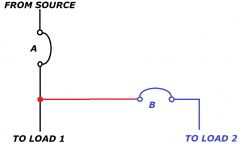Mr.electric
Member
- Location
- Minneapolis
Hello,
just going over one of mikes dvd videos on sizing motors taps. It’s a 10’ tap rule feeding a motor and he was saying you size it 1/10th the size of the feeder ampacity. Not sure if it just got missed between all the panel member but it looks like 240.21 (b) (1) (4). Says not less than 1/10th the rating of the device protecting the feeder, not the total feeder ampacity.
Also wondering, when sizing motor branch circuit overcurrent protection if the motor type and breaker type are not specifically listed is your default a 250% multiplier.
Thanks.
just going over one of mikes dvd videos on sizing motors taps. It’s a 10’ tap rule feeding a motor and he was saying you size it 1/10th the size of the feeder ampacity. Not sure if it just got missed between all the panel member but it looks like 240.21 (b) (1) (4). Says not less than 1/10th the rating of the device protecting the feeder, not the total feeder ampacity.
Also wondering, when sizing motor branch circuit overcurrent protection if the motor type and breaker type are not specifically listed is your default a 250% multiplier.
Thanks.

